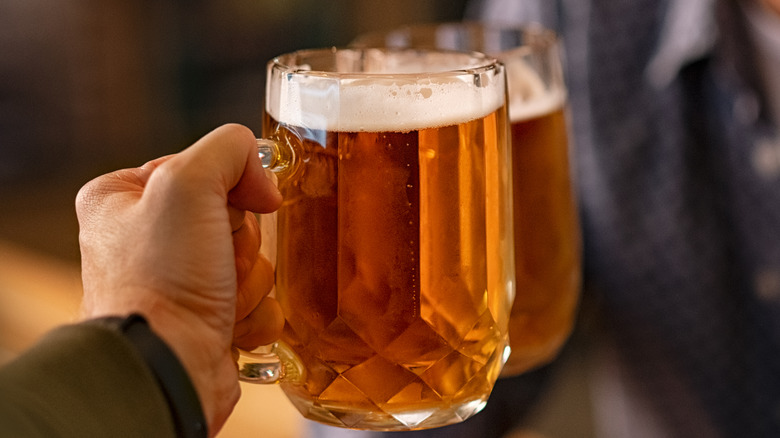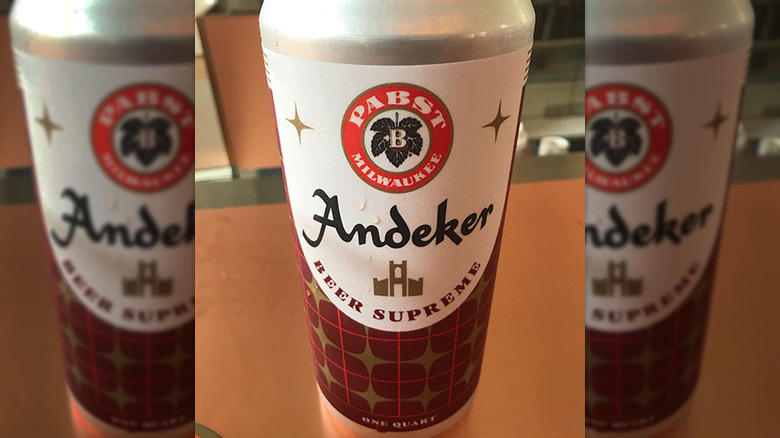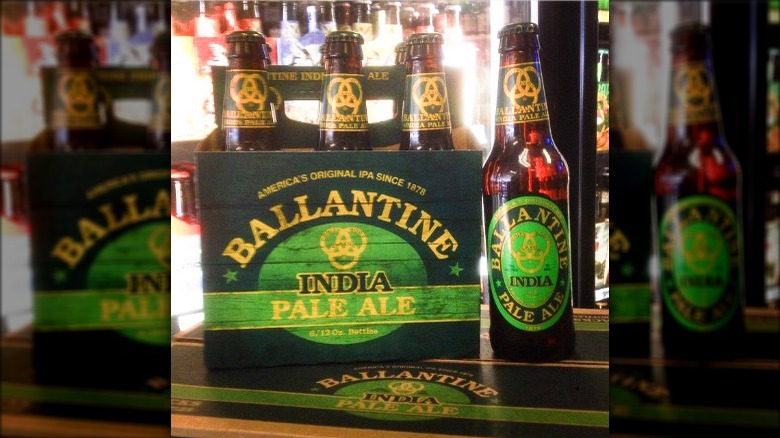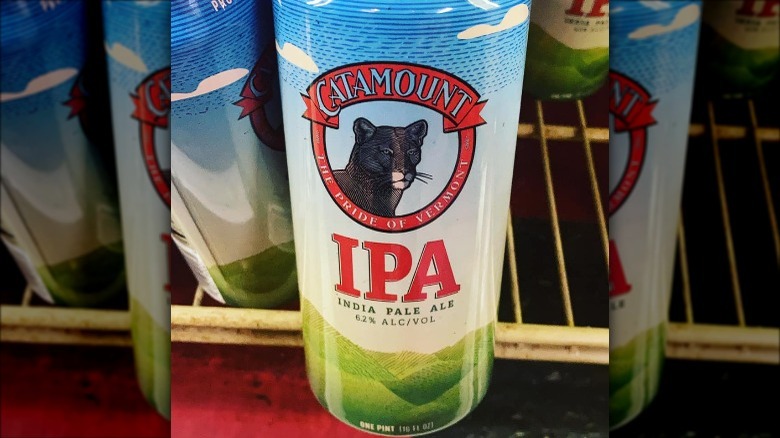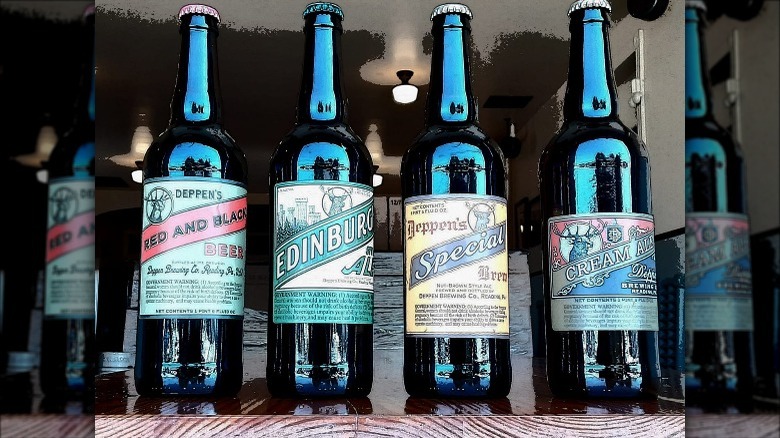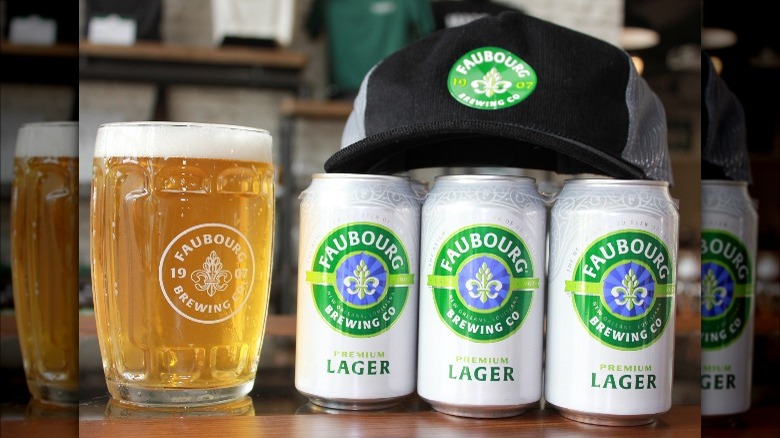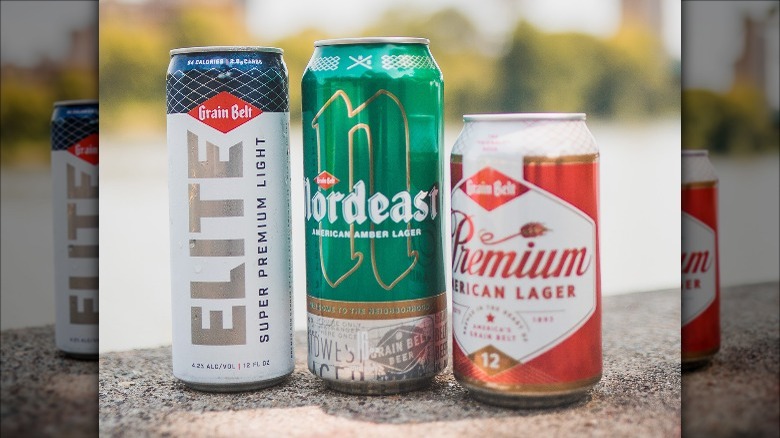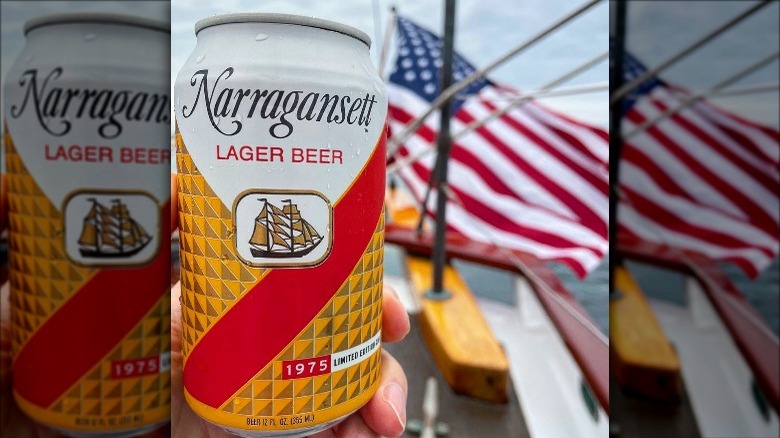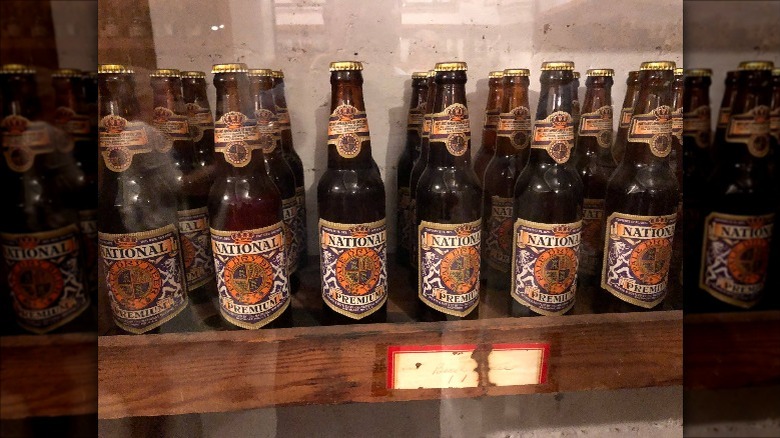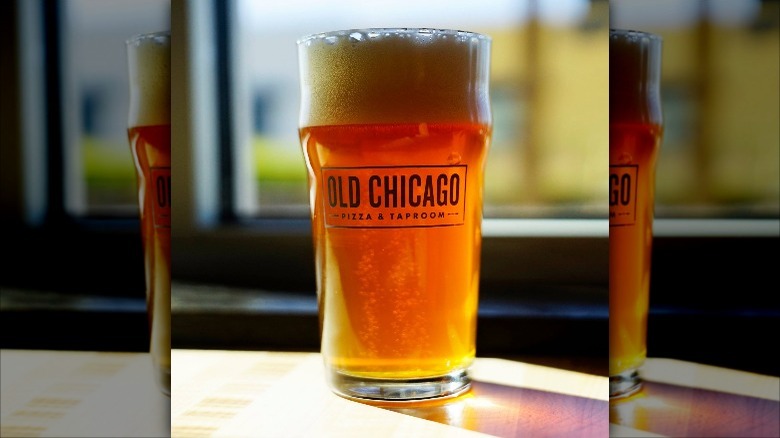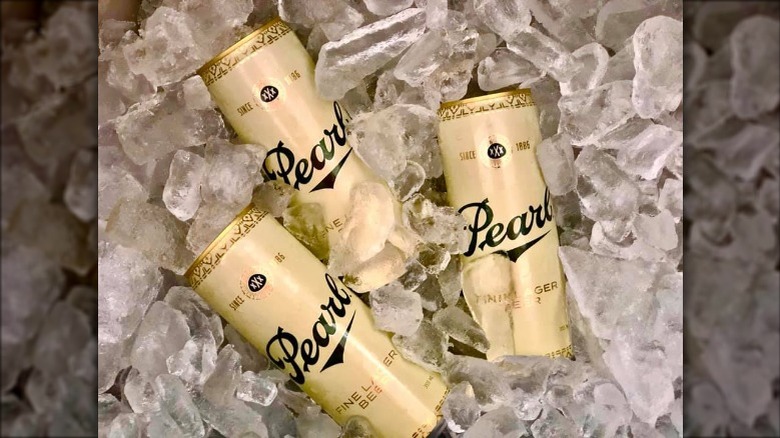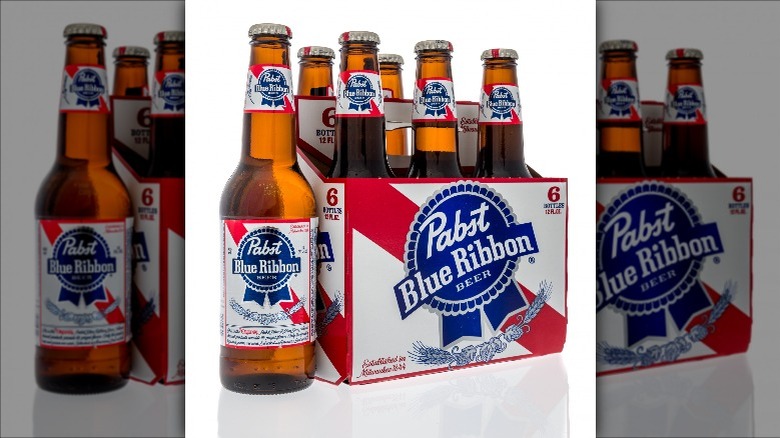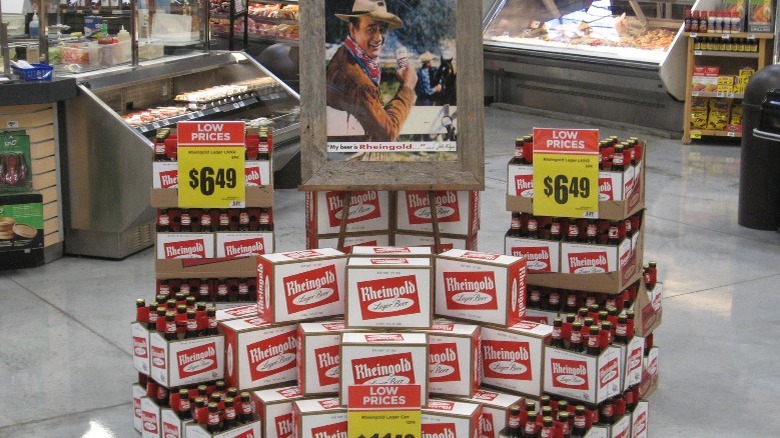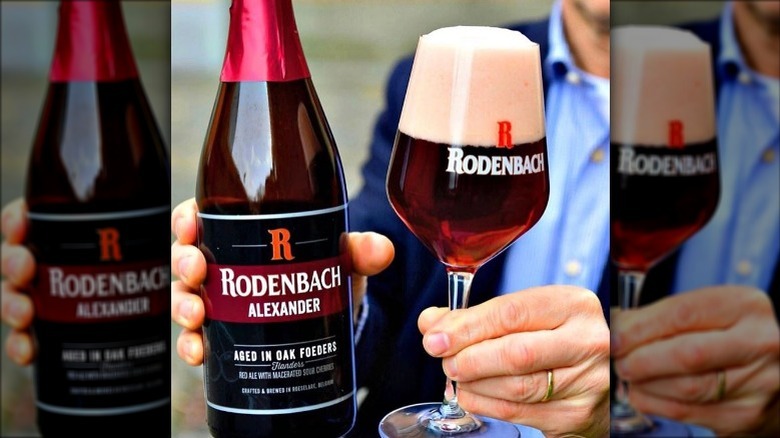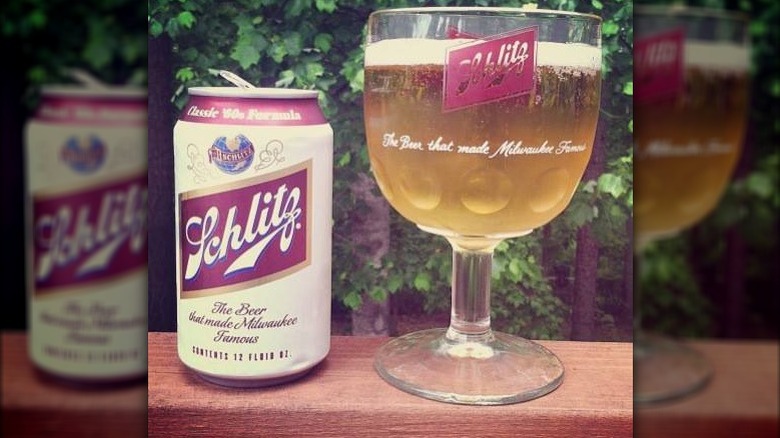14 Beers That Staged A Surprising Comeback
Every year — every single week, it seems — new kinds of beer are hitting the store shelves, which makes it kind of fun to go booze shopping since you never know what you're going to see. Oh, is sea salt guava gose now a thing? Okay, cool. Limoncello lager? We're in. Roasted brussels sprout IPA? Umm, no thanks. The only downside to the product cycle of life seems to be that while new beers are constantly being born, old ones get a one-way ticket to hops heaven.
Except, sometimes that ticket's not so one-way as all that. While public outcry alone isn't enough to bring a beer back from the dead, brewers and investors with a sentimental streak (or a dearth of innovation) may decide it's worthwhile to revive an old recipe. Some of the beers on this list are big names that you may not even have known went away for a while, while others are strictly regional brews that were born, died, and brought back only in their own home towns. A few of these beers were even born again not once, but several times. Although a handful of beers on this list have currently pressed pause, we're not ruling out another revival just yet.
1. Andeker
Andeker is an object lesson in how you can't keep a good brand down. Or bring it back up, if you choose to see the stein as half-empty, but we prefer to take a more optimistic outlook. Andeker, a German-type lager, dates back to the late 1930s, but was discontinued for the first time in the 1960s. It came back again in 1972 for a run that lasted through the rest of the decade and all the way up to 1986. Having seen us from Watergate up to Iran-Contra, the beer then bowed out again 32 for years.
In 2018, as per the Milwaukee Record, Pabst announced that Andeker would once more be brought back from their "vault." Whether an actual or metaphorical vault, they didn't say, but at any rate they revived the historic recipe to serve at the Pabst Milwaukee Brewery and Taproom. The brew, which one Beer Advocate user praised as a "wonderful malty helles lager," apparently lasted as long as the taproom itself did. Another user describes picking up a growler of Andeker just before the venue, renamed Captain Pabst Pilot House, closed down in late 2020. They called it a "fantastic beer" and said they "Would love to see this generally available," adding that "even an annual limited run would be appreciated." Well, if history's anything to go by, we haven't seen the last of Andeker yet, so we're hoping the fourth time's the charm.
2. Ballantine IPA
The Ballantine Brewery has a story that's not atypical — it started up in the 1800s in Albany, New York, and although it naturally shut down during Prohibition, it was up and running again come the repeal. It did, however, bounce around a bit, expanding into Newark, New Jersey, then later, once purchased by Falstaff, moving the brewing to Cranston, Rhode Island, where the brewers shared the facilities with Narragansett. Ballantine eventually ended up in the Pabst portfolio, at which point the beers were brewed first in Forty Wayne, Indiana, and then, finally, in Pabst's native Milwaukee. Ballantine itself never entirely went away -– Pabst continued making the XXX lager even when it shut down its Milwaukee brewing operation — but it did drop Ballantine IPA back in 1995.
Fast forward 19 years, and IPAs are the hipsters' darling. "Hmm," thinks Pabst, "don't we have a historic recipe for this stuff? Time to bring it back!" While the brewers seemingly intended to re-create a pre-1970s version of the brew, the Beer et seq. blog speculates that modern hops have lent the 2.0 Ballantine IPA a grapefruit-like flavor typical of many latter-day IPAs. Overall, though, many Beer Advocate users seem to appreciate the new brew, awarding it a score of 87. One reviewer calls it "A fantastic hop-forward brew that exemplifies east coast IPA's," while another says it's "Truly what an IPA should be."
3. Catamount
Catamount Brewing Company claims to have been the first craft brewer in the state of Vermont as they date back to the Orwellian dystopia days of 1984. They were pretty successful at the time, and one of their beers, a golden ale called Catamount Gold, earned a thematically appropriate gold medal at the Great American Beer Festival in 1989. Sadly, Catamount's golden years were numbered, as they packed it in when the new millennium was but a few months old (or not yet born, if you adhere to the theory that the 21stcentury began in 2001).
Catamount's demise, however, was not a permanent one. The brewery was sold to the Mass. Bay Brewing Company and became home to the Harpoon brand instead. Catamount, however, was revived as a small-batch label in its own right and today offers several different beers: a regular IPA, a seasonal hazy IPA and porter, and a maple wheat ale and Oktoberfest brew that are available in limited quantities.
4. Deppen
It's always a tricky proposition reviving a historic beer brand whose history only goes back a few decades. There are bound to be fans who, while thrilled to see their long-lost favorite back again, will complain bitterly that it doesn't hold a candle to what it was back in the 1990s, 1980s, or 1970s. Deppen, however, chose an easier route, as there aren't too many people around who could say whether their new version matches up to the one that was discontinued in 1937. As the drinking age in most states was still 21 back in the day, any first-gen Deppen drinkers (legal ones, at least) are over 100 years old.
So what brought Deppen back, if not demand from thirsty centenarians? According to the founder of the Oakbrook Brewing Company in Reading, Pennsylvania, it was an interest in the city's past. As Kyle Neuheimer told the Reading Eagle, "Reading has an incredibly rich and fascinating brewing history ... Our intent in reviving the Deppen Beer brand is to continue to shine a spotlight on that history." He also feels that the time is right, as many Oakbrook patrons are starting to prefer more traditional styles rather than today's trendy "hop bombs." While Neuheimer has no access to Deppen's recipes, he says that his brewers have a "pretty good idea" how best to recreate Deppen's cream ale, porter, bock, and other styles in such a way that they'll still appeal to the modern palate.
5. Dixie
Dixie is a beer with a bit of a different story than the other brands on this list. The actual brewery didn't go away, nor did any of its beers. Instead, it's the name itself that died while the brand was reborn under a new moniker. As to the reason for the rebranding, it occurred around the time of the Aunt Jemima makeover and for similar reasons. The song "Dixie," which dates back to 1859, was adopted as an unofficial anthem of the Confederacy and is still associated with the Lost Cause movement that romanticizes life in the antebellum South. So, yeah, not a good look in the 2020s (or ever).
Dixie, a brand that dates back to 1907, is originally from New Orleans, and has, in fact, recently returned to that city after more than a decade's absence necessitated by Hurricane Katrina. (The old brewery was a complete write-off.) The new name, however, is even more NOLA-appropriate: as of 2021, the beer is now sold under the label Faubourg, a French word that means "neighborhood" and is in common parlance in Crescent City. Faubourg's lineup as it currently stands includes not only the flagship lager formerly known as Dixie, but also specialty brews such as Blackened Voodoo dark lager and Beignet Au Lait imperial blonde ale.
6. Grain Belt
We love to divide up our country into unofficial regions like the Rust Belt or Bible Belt or Cotton Belt. Yet another region would be the Grain, aka Corn, Belt. According to World Atlas, this particular belt includes the state of Minnesota. As it turns out, the Gopher State is one of the nation's top producers of corn, who knew? (Minnesotans, probably.) While you might think they'd be making bourbon there, instead it seems they prefer to use some of their surplus crop in brewing the beer known as Grain Belt.
Grain Belt is a beer that's got a real case of the Midwestern stubbornness when it comes to hanging in there against all odds. The brewery started up operations back in the 1890s, and promptly burned down (at least, in part) within its first year. During Prohibition, it rebranded as "Golden Grain Juice Company" to sell low-alcohol "near beer." The brand was back in full gear once real beer became legal again, but finally went out of business in 2002, nine years after celebrating its centenary. It wasn't down and out for long, though, since the brand was promptly purchased by the August Schell Brewing Company. Today you can not only buy "the friendly beer" in its original lager form (some Beer Advocate users find that this product does, in fact, taste of sweet corn), but also in light, low-carb, and flavored versions.
7. Narragansett
Narragansett, the 130+-year-old beer that still holds the title of Rhode Island's favorite brew, didn't ever disappear entirely. Instead, like the coelacanth fish, reports of its extinction proved to be greatly exaggerated. Back in the 1950s, Narragansett pretty much ruled New England, with nearly ⅔ of the beer sold in the region being of this brand. While Narragansett held strong for a few more decades, gaining traction when its brew featured prominently in the movie "Jaws," it was steadily losing ground to big brews of the Bud/Miller/Coors variety.
A few years into the millennium, Narragansett was nearly dead. You know what saved it? Hipsters. Also investors, of course. The latter, however, saw that the former were interested not only in craft and microbrews, but in "old man" beers like Pabst Blue Ribbon (see below for a similar redemption story). A decade or so later, Narragansett was not only one of New England's most rapidly-growing brands (take that, Sam Adams!), but was making serious inroads into the not-insubstantial NYC market, as well. These days, it's clear that 'Gansett's long past relying on the old man market, as its current lineup includes such on-trend offerings as a coffee milk stout, a hard tea, and a mango/passionfruit shandy.
8. National Premium
While Baltimore's favorite beer may be National Bohemian (even if it's sadly been brewed out of state since 1996), they've actually got another "national" beer to call their own. National Premium, a beer that dates back to the 1930s, died out in the 1990s when it was purchased by Stroh's and the brand declined to keep brewing it. An attempt to revive it a few years later received the enthusiastic support of none other than Maryland's former governor William Donald Schaefer (Baltimore's beloved "Willie Don"), but still fizzled out.
A decade or so later, though, the name went up for sale and was purchased by a realtor from Maryland's Eastern Shore. Tim Miller was determined to bring back his dad's favorite beer and with the aid of a brewer who'd once worked for National Premium, he managed to pull it off. As of 2020, the beers were still brewed in Easton (Miller's home town), but plans were underway to move the brewing operation back to Natty Premium's original home on Baltimore's Brewer's Hill.
As of today, the beer is primarily available in the Baltimore area and on the Eastern Shore, but Miller's eventual goal is to be what he calls "The Maryland powerhouse beer." As he managed to bring National Premium back from the dead, who knows, he might even be able to establish a foothold throughout the mid-Atlantic region, or at least expand his reach into neighboring D.C. and Delaware.
9. Old Chicago
While Chicago has never been a big beer town (no need, what with its proximity to the real Brew City, Milwaukee), the city did have an old-school big name brewer of its own though: Peter Hand, makers of the now-defunct Meister Brau as well as the reincarnated Old Chicago.
While Old Chicago beer long predates the restaurant chain of the same name, we can't say there's no connection, since the latter OC led to the revival of the former brand. What happened was, Craft Works, the company that owns Old Chicago as well as the equally beer-centric Rock Bottom restaurant chain, purchased the rights to the Old Chicago name from Miller. This company had acquired (and dropped) Old Chicago back in the '70s, but it apparently didn't sell Craft Works the recipe. Rather than bringing back the Old Chicago of yore, the new owners instead applied the name to various specialty beers served solely in their restaurants such as the Old Chicago Old Curmudgeon Winter Warmer Ale that was brewed by Rock Bottom in Minneapolis.
We're not actually sure whether the restaurants are still doing these Old Chicago beers. A post by beer blog A Perfect Pint touting the return of Old Chicago was written in 2010, while Beer Menus shows that, as of December 2021, there were no Old Chicago-branded beers on the menu of the Old Chicago in Rockford, Illinois. Still, no matter how brief the revival, Old Chicago did stage a comeback and that's what counts.
10. Pearl
The state of Texas does have a few fairly well-known beers with national distribution such as Shiner and Lone Star. Once upon a time, there was a third Texan beer sold in 47 states: the Alamo City's own Pearl. This beer was brewed in San Antonio all the way from the 1880s up until Prohibition, then resumed operations again in the 1930s. Things weren't going so well for the brewery by the end of the century, though, and it shut down in 2001.
Neither the beer nor the brewery actually went away, though. Pearl, now the property of Pabst, was for two decades produced at that company's Fort Worth brewery, while the former San Antonio facilities were repurposed as shops, restaurants, and a luxury boutique hotel.
As of a few years ago, though, Pearl is back in town ... well, sort of. Even though a press release touts the re-launched brand as "paying homage to Pearl's deep roots while embracing the San Antonio of today," Texas Public Radio reports, that the new Pearl won't actually be brewed in San Antonio, but in the nearby Austin area. What's more, the brewers have tinkered with the formula a bit. Pearl's website calls its re-tooled product "a deluxe lager brewed for the modern Texas lifestyle," which apparently means that it's now got some citrus flavor to it. Another difference between Pearl 2.0 and Pearl in its heyday is that the new brew will be sold only in Texas.
11. Pabst Blue Ribbon
Pabst Blue Ribbon is a beer that's had its share of comebacks. The brand is one of the original American brews, dating back to the 1840s, but has had quite a checkered history over the past 180 years or so. In the 1930s, a post-Prohibition relaunch attempted to sell PBR as something swanky and luxurious, but apparently, this ad campaign didn't fly as it soon became seen as more of a Joe Sixpack kind of brew. In fact, by the end of the 20thcentury, it was no longer in fashion even at the lower end of the economic spectrum, despite getting a bump from the 1986 movie "Blue Velvet." (The movie must have done something to boost its sales, even if briefly, since Pabst commemorated it with a 30th-anniversary limited release bottle.)
By the early '00s, however, PBR was on the comeback trail. What brought them back? As Eric Shepard, an editor with "Beer Marketer's Insight," told NBC News in 2004, the blue-collar brew apparently appealed to "a consumer that's anti-marketing" -– yep, hipsters who went for its nostalgia appeal (just the thing to go with those manual typewriters and vinyl records). Despite PBR's newfound popularity, Miller/Coors, which now does the brewing for Pabst, threatened to drop the brand in 2016, but Pabst kicked up such a fuss that the big shots eventually relented and Pabst Blue Ribbon was saved once again.
12. Rheingold
Brooklyn, it seems, was the hipster mecca of the East Coast even 100+ years ago. As Brownstoner relates, by the end of the 19thcentury the borough had nearly 50 microbrewers. One of these, Liebmann's by name, eventually rose to the level of macrobrewery based on the success of its signature brew: Rheingold, a light lager that took its name from a Wagnerian opera. Marketing itself as "the dry beer," Rheingold was super-successful through the first half of the 20thcentury. It sponsored the Mets and even had its own beauty pageant, the Miss Rheingold Contest.
By the 1970s, however, Rheingold had lost serious ground to Coors/Miller/Bud (sound like a familiar story?), and in 1978 the brewery was out of business. The brand was revived in the late 1990s, but the nostalgia-based marketing didn't really take, nor did an attempt to update Miss Rheingold by giving her tattoos and an attitude. The company changed hands in 2010 to new owners who tweaked the formula, but even this failed to save it. While Rheingold's website is still up and Beer Advocate users report drinking the stuff up through May of 2022, the site lists the brewery as out of business so it seems as if this beer may have gone down for the third time.
13. Rodenbach Alexander
Rodenbach is a Belgian brewer that celebrated its bicentennial in 2021. As might be expected of any business a few centuries old, the names signing the paychecks have changed over the years. In 1998, the brewery was acquired by Palm Brewery. While the acquisition itself might have been no big deal, the subsequent announcement that it would be dropping Alexander, its beloved cherry-flavored Flanders-style red ale, had Belgian beer connoisseurs in a tizz. According to Hop Culture, some Alexander fans even paid up to $1,000 for the stuff on the black market. Well, they must have felt pretty silly if they did so in 2015, as Rodenbach brought this beer back in 2016.
As of spring 2022, Rodenbach Alexander appears to be living happily ever after. Beer Advocate gives the revived beer a score of 98, which they say means "world class," and recent reviewers have praised its flavor as a "Pretty amazing and balanced mix of sweet and tart" and lauded the beer as "nicely crafted and quite easy drinking." One fan even described it as "Worth finding and buying an excessive amount of," which is sound advice in the event that they ever do decide to discontinue it again.
14. Schlitz
Schlitz was the original "beer that made Milwaukee famous," although it certainly had a lot of competition back in the day. Brew City was once home to around 100 different brewers, including such big names as Pabst and Miller. Schlitz, however, was the undisputed champ for the entire first half of the 20thcentury, minus a little hitch in its giddyup during the years when booze was banned.
In the mid-1950s, though, a brewery worker strike opened the door for a new King of Beers. As the century wore on, the product itself deteriorated to the point where 1970s Schlitz was just bad beer. A slightly threatening ad campaign did the brand no favors, either, and the Milwaukee brewery closed up shop in 1981 (via Vinepair).
Schlitz was down, but not out. The brewery was first sold to Stroh's, then to Pabst. The beer didn't ever quite disappear, but instead morphed into a malt liquor version that apparently bore little resemblance to the pilsner it once was. While the original Schlitz recipe was presumed lost, Pabst eventually attempted to recreate it by interviewing brewery old-timers and consulting archival notes. The re-released Schlitz, once more brewed in Milwaukee, hit store shelves there in 2008 and the revamped version was an instant hit, While new/old Schlitz may not be posing much of a threat to Bud these days, it's still holding strong nearly 15 years post-reintroduction. Total Wine users rate it 4.8 stars and call it "A truly underappreciated domestic beer."
